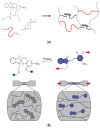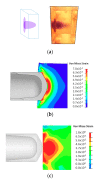'Seeing' Strain in Soft Materials
- PMID: 30717294
- PMCID: PMC6384768
- DOI: 10.3390/molecules24030542
'Seeing' Strain in Soft Materials
Abstract
Several technologies can be used for measuring strains of soft materials under high rate impact conditions. These technologies include high speed tensile test, split Hopkinson pressure bar test, digital image correlation and high speed X-ray imaging. However, none of these existing technologies can produce a continuous 3D spatial strain distribution in the test specimen. Here we report a novel passive strain sensor based on poly(dimethyl siloxane) (PDMS) elastomer with covalently incorporated spiropyran (SP) mechanophore to measure impact induced strains. We have shown that the incorporation of SP into PDMS at 0.25 wt% level can adequately measure impact strains via color change under a high strain rate of 1500 s-1 within a fraction of a millisecond. Further, the color change is fully reversible and thus can be used repeatedly. This technology has a high potential to be used for quantifying brain strain for traumatic brain injury applications.
Keywords: impact strain; mechanophore; poly(dimethyl siloxane); spiropyran; strain sensing.
Conflict of interest statement
The authors declare no conflict of interest.
Figures






References
-
- Lane B., Sherratt P., Hu X., Harland A. Measurement of Strain and Strain Rate during the Impact of Tennis Ball Cores. Appl. Sci. 2018;8:371. doi: 10.3390/app8030371. - DOI
-
- Trexler M.M., Lennon A.M., Wickwire A.C., Harrigan T.P., Luong Q.T., Graham J.L., Maisano A.J., Roberts J.C., Merkle A.C. Verification and implementation of a modified split Hopkinson pressure bar technique for characterizing biological tissue and soft biosimulant materials under dynamic shear loading. J. Mech. Behav. Biomed. Mater. 2011;4:1920–1928. doi: 10.1016/j.jmbbm.2011.06.008. - DOI - PubMed
-
- Beberniss T.J., Ehrhardt D.A. High-speed 3D digital image correlation vibration measurement: Recent advancements and noted limitations. Mech. Syst. Signal Process. 2017;86:35–48. doi: 10.1016/j.ymssp.2016.04.014. - DOI
-
- Wang Z.Y., Li H.Q., Tong J.W., Ruan J.T. Statistical analysis of the effect of intensity pattern noise on the displacement measurement precision of digital image correlation using self-correlated images. Exp. Mech. 2007;47:701–707. doi: 10.1007/s11340-006-9005-9. - DOI
MeSH terms
Substances
Grants and funding
LinkOut - more resources
Full Text Sources

